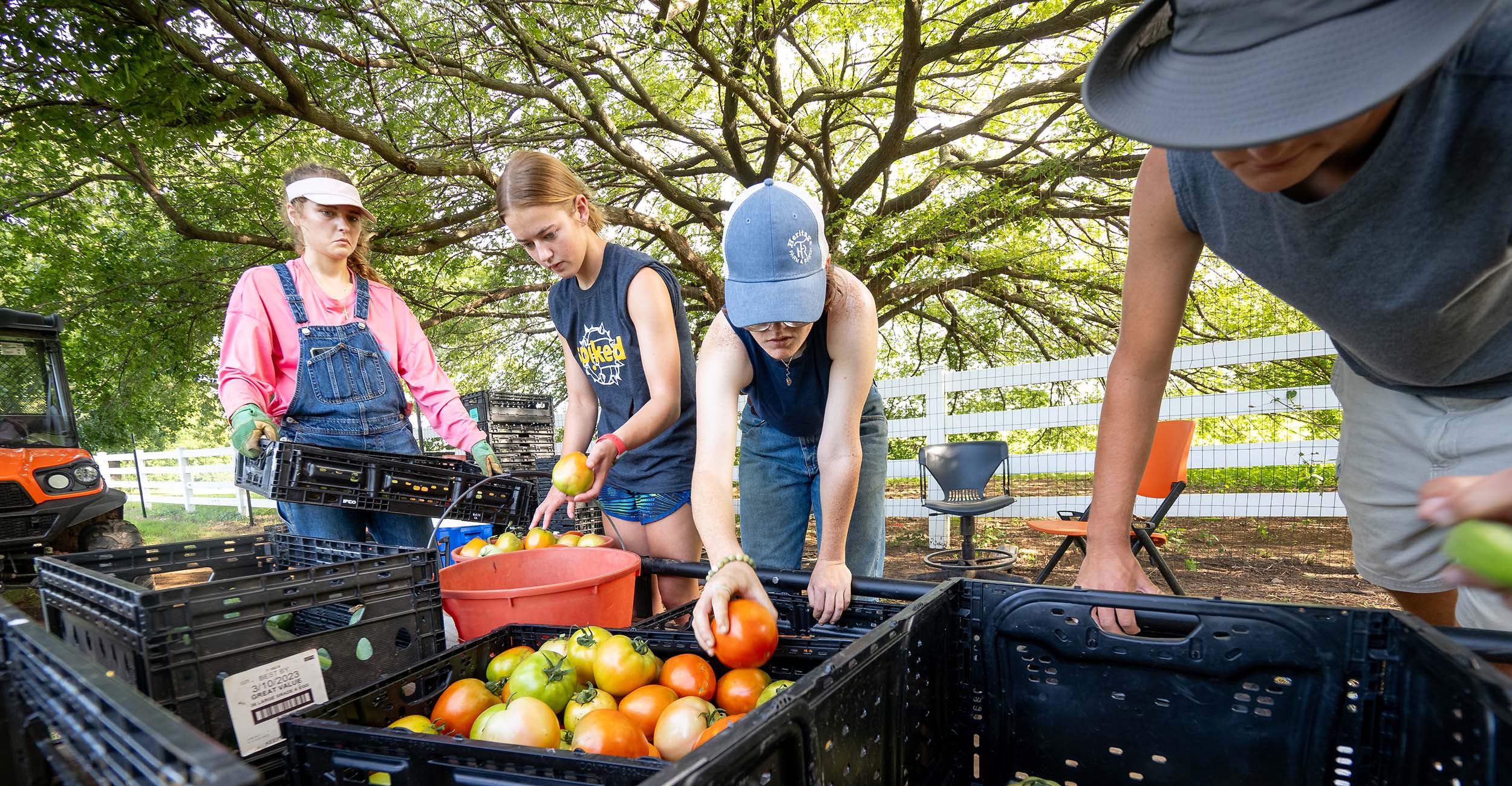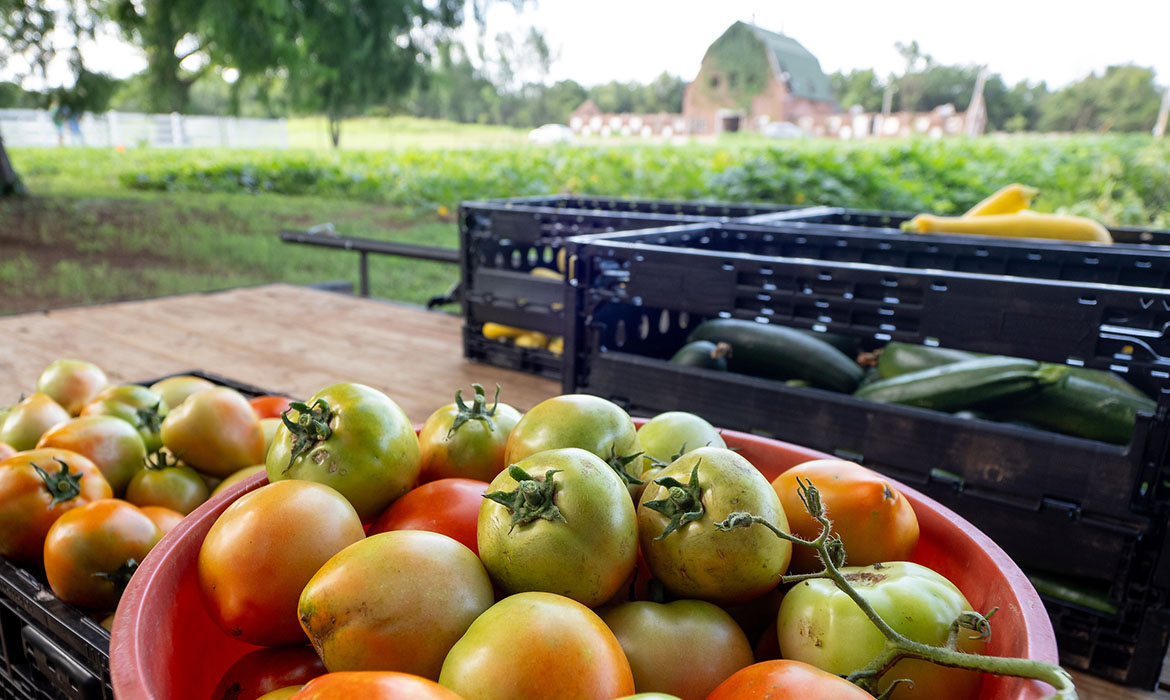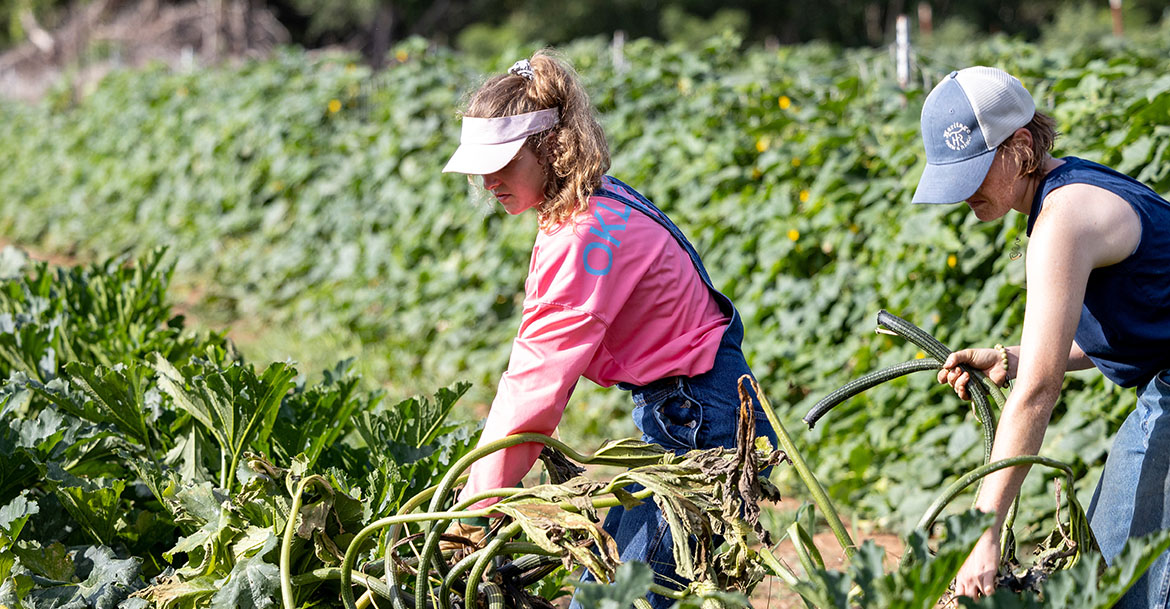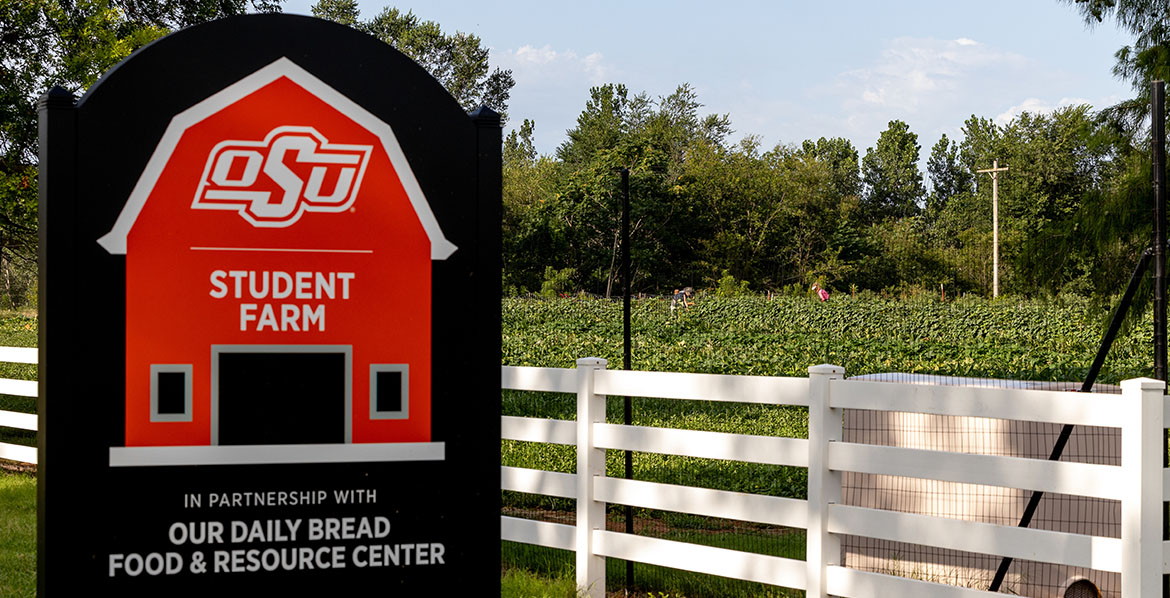
OSU Student Farm helps bridge the gap of food insecurity
Monday, September 11, 2023
Media Contact: Trisha Gedon | Sr. Communications Specialist | 405-744-3625 | trisha.gedon@okstate.edu
A collaborative effort among Oklahoma State University’s Division of Agricultural Sciences and Natural Resources and Stillwater’s Our Daily Bread Food and Resource Center provides experiential learning opportunities for OSU students and helps address food insecurity in Payne County.
The new OSU Student Farm grows fresh produce and donates it to Our Daily Bread. The farm is located on the west side of Stillwater at the former site of the OSU Swine Research and Education Center.
Jayson Lusk, vice president and dean of OSU Agriculture, said the farm offers new experiences for students.
“Farming produce encompasses a range of learning opportunities that are related to agriculture, nutrition, soil health, irrigation and the agribusiness sector,” Lusk said. “The hands-on experience students will gain at the new farm will benefit them far beyond the classroom. I appreciate the dedication and groundwork laid by Darren Shrum to help bring this endeavor to fruition for OSU Agriculture, our students and the community.”
OSU First Cowboy Darren Shrum understands the importance of collaboration between the community and OSU.
“The OSU Student Farm aligns perfectly with the university’s land-grant mission of teaching, Extension and research,” Shrum said. “The plans for this project reach more than just agriculture. All colleges can be involved, from engineering to human sciences. It also ties into the university’s focus on One Health and the importance of eating right from the start.”

Rachael Condley, executive director of Our Daily Bread, said the collaborative effort has a positive impact on Payne County residents facing food insecurity.
“Before this partnership, we had to limit our guests to one bag or less of fresh produce,” she said. “What we had been receiving from retail outlets in town was near the end of shelf life, and we didn’t know what would be donated each time. We appreciated what we received, but it wasn’t enough to meet all of the needs of our guests.”
Now, with a steady stream of fresh produce, those who visit Our Daily Bread for groceries can usually have two or more bags of produce, including cucumbers, broccoli, lettuces, zucchini, yellow squash, tomatoes, green beans, okra, sweet corn, cabbage, kohlrabi, cauliflower, spinach, onions and more.
“We know exactly what produce we will receive regularly from the Student Farm, and that helps us with our educational efforts with our guests,” Condley said. “We are working to partner more with the Payne County OSU Extension office to provide recipes and information on cooking methods and food preservation specific to the foods that are available at that time.”
When people have limited food budgets, Condley said they often try to stretch their dollars by purchasing items that fill them up and cost less but are typically less nutritious. With the abundance of fresh produce available from the Student Farm, guests are eating more nutrient-dense meals and learning new cooking techniques.
Condley said she has received messages from food bank guests and seen photos on the Our Daily Bread Facebook page that show how visitors are using the fresh produce.
“They’re so proud of the meals they’re now able to provide for their families,” she said.
Lynda Carrier of OSU Extension and the Department of Horticulture and Landscape Architecture said more than 44,000 pounds of produce have been harvested to date, and they continue to harvest every day.
“Currently, we’re working on two-and-a-half acres of land, but there are plans to expand and use the other two-and-a-half acres on the other side of the driveway in the future,” Carrier said.
Getting to harvest took some time and involved many steps to prepare the garden area. Carrier said the process began in September 2022 with soil samples and spraying the ground to kill the grass. Trees were removed, and the land was leveled before amending the soil.
“Next, we planted a cover crop of crimson clover and wheat and strip-tilled the rows to help build more organic matter in the soil,” Carrier said. “Also, an irrigation system was installed, along with an 8-foot deer fence around the garden area.”
Matt Beartrack of OSU Extension and the Department of Horticulture and Landscape Architecture said they also installed free-standing raised beds.
“The rounded beds hold water well, but they also drain well, which is good for plant production,” Beartrack said. “The buried irrigation system puts water where it needs to be to avoid waste. We also added nutrients to the drip irrigation system, so the fertilizer goes exactly where it’s needed, and we can avoid doing a broadcast application.”
Both Carrier and Beartrack serve as co-managers of the Student Farm and are coordinating with the student volunteers, faculty class projects and others who are working daily on the project.
About 8,000 cool-season transplants started in January at the Greenhouse Learning Center on campus were planted at the Student Farm in March. In April, the first romaine lettuce was harvested, and warm-season crops were planted.
Justin Quetone Moss, head of OSU’s Department of Horticulture and Landscape Architecture, said this effort benefits not only the residents of Payne County but also OSU students.
“Our students are required to do an internship for their degree program. Working at the Student Farm gives the students hands-on learning opportunities in areas such as crop management, harvesting and operating equipment,” he said. “We’re able to provide opportunities like this before we send them out into the industry on an internship. What the students learn makes them more employable and desirable coming out of our programs.”

Parker Lastovica, a senior horticulture and business major, has worked at the Student Farm since January. He said his favorite part of the job is learning about plants growing in a commercial setting.
“Commercial vegetable production is what I want to do,” Lastovica said. “I’m learning about pest problems and plant diseases. It’s one thing to learn about these things in a classroom setting, but it’s something else to see it in real life.”
Our Daily Bread also helps stock Pete’s Pantry, a food bank available to OSU students, as well as a satellite site at Lincoln Academy, part of Stillwater Public Schools. Moss said previously there was not enough fresh produce available for these resource sites, but the Student Farm has filled that gap.
“We’ve been able to provide so much quality food that has a longer shelf life, and the farm will continue to produce through October or November, depending on the weather,” he said. “The OSU Student Farm is a great collaborative effort for our community.”
OSU Agriculture is comprised of the Ferguson College of Agriculture and two state agencies: OSU Extension and OSU Ag Research. The mission of a land-grant university is to provide research-based information and services that enhance the lives of residents.
Lusk said while this project is underway in Stillwater, there are state-wide opportunities through OSU Extension to provide produce to address food insecurity.
“Part of OSU’s strategy and land-grant mission is to use our research strengths to solve some of society’s most pressing problems,” Shrum said. “This project accomplishes that at a grass-roots level. If you have a heart for people, you’re going to love this project.”
The OSU Student Farm is meeting a critical need in Payne County while demonstrating cutting-edge sustainable food production methods to students.

“It gives them a chance to get their hands in the soil,” Lusk said. “Plus, the farm offers research opportunities to grow higher-yielding crops that use less water, advancing the overall agricultural industry.”
Follow the “Oklahoma Gardening” YouTube channel for regular updates on the OSU Student Farm.
